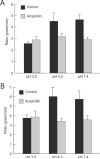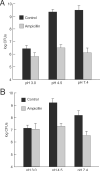The effects of varying acidity on Helicobacter pylori growth and the bactericidal efficacy of ampicillin
- PMID: 23009227
- PMCID: PMC3474890
- DOI: 10.1111/apt.12059
The effects of varying acidity on Helicobacter pylori growth and the bactericidal efficacy of ampicillin
Abstract
Background: Penicillins inhibit cell wall synthesis; therefore, Helicobacter pylori must be dividing for this class of antibiotics to be effective in eradication therapy. Identifying growth responses to varying medium pH may allow design of more effective treatment regimens.
Aim: To determine the effects of acidity on bacterial growth and the bactericidal efficacy of ampicillin.
Methods: H. pylori were incubated in dialysis chambers suspended in 1.5-L of media at various pHs with 5 mM urea, with or without ampicillin, for 4, 8 or 16 h, thus mimicking unbuffered gastric juice. Changes in gene expression, viability and survival were determined.
Results: At pH 3.0, but not at pH 4.5 or 7.4, there was decreased expression of ~400 genes, including many cell envelope biosynthesis, cell division and penicillin-binding protein genes. Ampicillin was bactericidal at pH 4.5 and 7.4, but not at pH 3.0.
Conclusions: Ampicillin is bactericidal at pH 4.5 and 7.4, but not at pH 3.0, due to decreased expression of cell envelope and division genes with loss of cell division at pH 3.0. Therefore, at pH 3.0, the likely pH at the gastric surface, the bacteria are nondividing and persist with ampicillin treatment. A more effective inhibitor of acid secretion that maintains gastric pH near neutrality for 24 h/day should enhance the efficacy of amoxicillin, improving triple therapy and likely even allowing dual amoxicillin-based therapy for H. pylori eradication.
© 2012 Blackwell Publishing Ltd.
Figures



Similar articles
-
Colloidal bismuth subcitrate impedes proton entry into Helicobacter pylori and increases the efficacy of growth-dependent antibiotics.Aliment Pharmacol Ther. 2015 Oct;42(7):922-33. doi: 10.1111/apt.13346. Epub 2015 Aug 4. Aliment Pharmacol Ther. 2015. PMID: 26238858 Free PMC article.
-
Factors affecting growth and antibiotic susceptibility of Helicobacter pylori: effect of pH and urea on the survival of a wild-type strain and a urease-deficient mutant.J Med Microbiol. 1996 Jun;44(6):425-33. doi: 10.1099/00222615-44-6-425. J Med Microbiol. 1996. PMID: 8636959
-
Comparative in vitro antimicrobial susceptibility and synergistic activity of antimicrobial combinations against Helicobacter pylori isolates in Taiwan.J Microbiol Immunol Infect. 2015 Feb;48(1):72-9. doi: 10.1016/j.jmii.2012.08.021. Epub 2012 Oct 1. J Microbiol Immunol Infect. 2015. PMID: 23036269
-
Acid, protons and Helicobacter pylori.Yale J Biol Med. 1996 May-Jun;69(3):301-16. Yale J Biol Med. 1996. PMID: 9165699 Free PMC article. Review.
-
Clarithromycin and omeprazole as helicobacter pylori eradication therapy in patients with H. pylori-associated gastric disorders.Drugs. 1996 Jan;51(1):161-78. doi: 10.2165/00003495-199651010-00010. Drugs. 1996. PMID: 8741237 Review.
Cited by
-
The Impact of Gastric Juice pH on the Intraluminal Therapy for Helicobacter pylori Infection.J Clin Med. 2020 Jun 14;9(6):1852. doi: 10.3390/jcm9061852. J Clin Med. 2020. PMID: 32545856 Free PMC article.
-
Helicobacter pylori Biofilm Confers Antibiotic Tolerance in Part via A Protein-Dependent Mechanism.Antibiotics (Basel). 2020 Jun 24;9(6):355. doi: 10.3390/antibiotics9060355. Antibiotics (Basel). 2020. PMID: 32599828 Free PMC article.
-
The role of acid inhibition in Helicobacter pylori eradication.F1000Res. 2016 Jul 19;5:F1000 Faculty Rev-1747. doi: 10.12688/f1000research.8598.1. eCollection 2016. F1000Res. 2016. PMID: 30023042 Free PMC article. Review.
-
Vonoprazan: A Review in Helicobacter pylori Infection.Drugs. 2024 Mar;84(3):319-327. doi: 10.1007/s40265-023-01991-5. Epub 2024 Feb 23. Drugs. 2024. PMID: 38388872 Free PMC article. Review.
-
Vonoprazan-Based Third-Line Therapy Has a Higher Eradication Rate against Sitafloxacin-Resistant Helicobacter pylori.Cancers (Basel). 2019 Jan 19;11(1):116. doi: 10.3390/cancers11010116. Cancers (Basel). 2019. PMID: 30669474 Free PMC article.
References
-
- Suerbaum S, Michetti P. Helicobacter pylori infection. N Engl J Med. 2002 Oct 10;347(15):1175–86. - PubMed
-
- Blaser MJ. Helicobacter pylori: its role in disease. Clin Infect Dis. 1992 Sep;15(3):386–91. - PubMed
-
- Nomura A, Stemmermann GN, Chyou PH, Kato I, Perez-Perez GI, Blaser MJ. Helicobacter pylori infection and gastric carcinoma among Japanese Americans in Hawaii. N Engl J Med. 1991 Oct 17;325(16):1132–6. - PubMed
-
- Parsonnet J, Friedman GD, Vandersteen DP, Chang Y, Vogelman JH, Orentreich N, et al. Helicobacter pylori infection and the risk of gastric carcinoma. N Engl J Med. 1991 Oct 17;325(16):1127–31. - PubMed
Publication types
MeSH terms
Substances
Grants and funding
LinkOut - more resources
Full Text Sources
Medical
